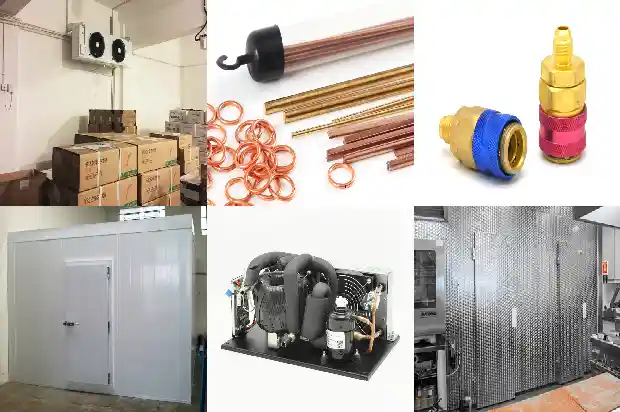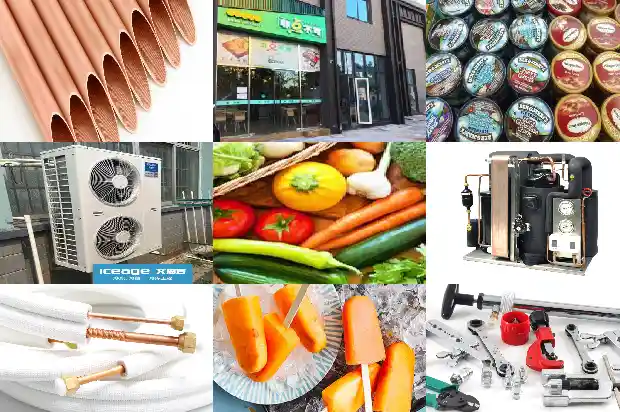The Panels of the Combined Cold Storage—Seemingly Simple?
2025-03-04
A combined cold storage refers to a cold storage whose panels, evaporators, etc. are pre-manufactured in the factory and can be assembled on-site for use. Due to the fact that its storage body can be freely combined and partitioned according to the needs of users, and it is convenient for installation and relocation, it is commonly used in small and medium-sized freezing (refrigerating) high and low temperature cold storages, food processing rooms for cold processing, controlled atmosphere cold storages, etc. The panels (hereinafter referred to as panels) that make up the storage body of the cold storage are mass-produced in the factory using molds, and after being transported to the site, they are connected and assembled through the concave and convex grooves inside the panels.
The core layer materials of the panel are:

The core layer materials of the panel are:
- Polyurethane foam plastic: It is a flat plate or a shaped plate produced mainly from polyols and isocyanates, and the finished product is made after laminating or veneering with metal sheets or other materials. The one used for the panel is rigid polyurethane foam plastic, which has multiple types. According to the usage, there are two types: Type I is suitable for bearing light loads, and Type II is suitable for heavy loads. According to the thermal conductivity, it is classified into two grades, A and B. According to the combustion performance, it is divided into three grades. The combustion performance of the polyurethane sandwich panel complies with Class B1 specified in GB/T8624.
- Polystyrene foam plastic: According to the combustion performance, it is divided into flame-retardant type and ordinary type. The flame-retardant type is mixed with colored particles to distinguish it from the ordinary type. According to the density, it is divided into six categories: Category I is suitable for positions that do not bear loads, such as sandwich materials and walls; Category II is suitable for places with smaller loads, Category III is suitable for places with larger loads such as parking platform positions; Categories IV, V, and VI are suitable for cold storage flooring materials, foundation materials, and materials with higher compressive strength.
The panel materials of the sandwich panel:
There are colored coated steel plates (polyester coating, fluorocarbon coating, PVC coating), aluminum alloy plates, galvanized steel plates, stainless steel plates, and galvalume steel plates. The exposed coating of the panel should be non-toxic, odorless, and not contaminate food.
Colored coated steel plate: The base plate is a hot-dip galvanized steel plate.
Aluminum alloy plate: Grades 5A02, 3A21.
Galvanized steel plate: Steel strip 275 - SC - X - L - GB/T 2518.
The specifications and models of the sandwich panel:
- Thickness (mm): 50, 60, 75, 100, 125, 150, 175, 200, 225, 250, 275, 300, 325, 350.
- Width (mm): 1150 for the rigid polyurethane sandwich panel, and 1200 for the polystyrene sandwich panel. It can also be determined through negotiation with the supplier.
- Density (Kg/m³): The density of the rigid polyurethane foam plastic ranges from 32 to 50, and the commonly used ones are 32±2, 36±2, 40±2, and it can also be specially customized. The density of the polystyrene foam plastic has six categories, ranging from 15 to 60, and most of the walls are 20±2.
- Product code: JPB or JEB, where: J represents a metal panel, P represents rigid polyurethane foam plastic, E represents polystyrene foam plastic, and B represents a plate shape. Example: JPB6000×1150×100mm indicates a metal-faced rigid polyurethane insulation sandwich panel with a length of 6000mm, a width of 1150mm, and a thickness of 100mm.
As a user, the following aspects are generally inspected and accepted:
- Check the factory materials of the product: The quality guarantee certificate of the raw materials and the product quality certificate. The contents on the certificate include the product name, trademark, production date and batch number, the name of the manufacturer, the implementation standard number, the product inspection report form, etc. The product has product markings, trademarks, etc.
- Visually inspect the appearance of the product:
(1) For the rigid polyurethane sandwich panel:
① The surface should be flat, and there should be no obvious scratches, bumps, and foam flashing edges and other defects. The surface should be clean, with uniform color, and there should be no adhesive marks, oil stains, etc.
② For the plug-in sandwich panel, the foam on both sides should be flat, and there should be no concave and convex defects with a depth or height of 2mm and an area larger than 1cm².
③ The parallelism tolerance and perpendicularity tolerance of the upper and lower two layers of panels should not exceed 2mm.
④ When the sandwich panel is used as a wall panel, the thickness deviation within 200-250mm from the end is within ±5mm. When the sandwich panel is used as a ceiling panel, the thickness deviation within 100mm from the end is within ±5mm.
⑤ The flatness of the sandwich panel within 2mm is considered qualified.
(2) For the polystyrene sandwich panel:
① The surface should be flat, without obvious unevenness, warping, and deformation, the surface should be clean, with uniform color, and there should be no adhesive marks, oil stains, etc.
② Except for the curled edges and cut edges, there should be no obvious scratches, bumps, etc. on the rest of the panel surface.
③ The cut should be straight, and there should be no obvious warping corners, delamination, and waviness at the edges of the plate, and the panel is easy to bend inward. The panel is firmly bonded to the core layer.
④ The surface is protected by a film, and the protective film should be removed after the installation is completed. - After installation and use, under the nominal working conditions, after the temperature inside the storage reaches the designed temperature, there should be no condensed water flowing on the outer surface of the storage body.
Precautions during transportation and storage:
- Smoking and open flames are strictly prohibited during transportation and storage.

- Do not apply heavy pressure, drop it violently, or collide it with sharp objects during handling to avoid mechanical damage.
- Store it in a dry and ventilated warehouse, away from heat sources.
- It is not suitable for long-term open-air storage and long-term exposure to the sun. There should be rainproof measures when storing it outdoors.
- When the panel is placed flat, use wooden boards and other materials to cushion the bottom of the stack. If wooden strips are used, the spacing of the cushioning wood should be less than 2m.
Related Articles
- Technical Features and Quality Judgment of Stainless Steel Cold Storage Panels
- What Issues Should Be Considered in the Installation of a Cold Storage?
- What to Do When the Condensing Pressure of the Cold Storage Is Too Low in Winter?
- Common Fault Causes and Solutions of Cold Storage Systems
- Installation, Inspection and Debugging of the Cold Storage Body
- Is the Compressor of the Cold Storage Unit Overheating? Find the Reasons Here!
- Installation Precautions and Accessory Selection for Cold Storage Unit
- How Do You Remove Mildew from the Cold Storage? Have You Used These Methods?
- How to Inspect and Troubleshoot the Faults of the Control Valve in the Cold Storage?
- Analysis of the Composition, Control and Operation Process of Cold Storage System
- Refrigeration Components of Refrigeration
- Which is Better for Cold Storage: Cooling Coils or Air Coolers?
- What Are the Acceptance Standards for Cold Storage Design and Installation?
- What issues should be noted during the installation of a small - scale cold storage?
- What Are the Common Reasons for Difficulties in Cooling a Cold Storage?
- Introduction to Inspection and Handling Methods for Refrigerant Leak in Cold Storage
- How to Resolve the Scuffing Issue of Cold Storage Compressors
- What is the Correct Operation Method of the Distribution Box during Cold Storage Installation?
